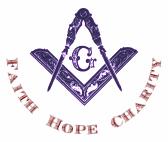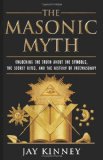Review: "The Masonic Myth" by Jay Kinney

Main | Speaking | Web Resources | Erik's Masonic Journey | Curriculum Vitae
Copyright © 2010-2020 Erik L. Arneson
The Masonic Myth

Jay Kinney has a talent for navigating through the fog surrounding Freemasonry. In The Masonic Myth: Unlocking the Truth About the Symbols, the Secret Rites, and the History of Freemasonry (HarperOne, 2009, ISBN 0-060-82256-2) he presents a view of the Craft that is low on jargon and nonsense. The book addresses many rumors and legends and compares them to what we really know about Masonic history. After a summary of the evolution of the Premier and Antient Grand Lodges, he takes us through the connections between Freemasonry and the Knights Templar, a history of Continental Freemasonry, and its possible links to Jacobites, political revolution, and the Enlightenment.
Kinney describes the role of Freemasonry in the modern world as one that provides a rite-of-passage into adulthood and "graduation from perpetual adolescence." He examines the human desire for ritual, the possible meaning and obsolescence of the notorious Masonic secrecy, and other difficult topics.
A Tangle of Degrees
Kinney's approach to explaining the confusing jumble of Masonic side-degrees, appendant bodies, and concordant organizations is amazingly lucid. As a Freemason, it is hard for me to know if his explanation is clear enough for the non-Mason. But I cannot imagine a better way to explain the tangle, and I would love to produce his book for the next person to inquire of me on the subject and say, "Read this."
In addition to discussing the history and structure of both the York and Scottish Rites, Kinney discusses a few lesser-known rites and also describes the evolution of hautes grades in European or Continental Freemasonry. He tries to explain, and I think he does it well, the concept of Grand Lodges and the various authorities they have over different rituals, a confusing subject for non-Masons.
Conspiracy!?!
"The world of conspiracy theories and theorists is a peculiar place," Kinney writes. "Most of its inhabitants live under a permanent Red Alert, certain that our destinies are being shaped by hidden forces behind the scenes." He is ruthless in his dissection of the legion of fringe theories revolving around the Craft, and spares neither the romantic legendary history of the fraternity nor the Illuminati-soaked paranoia of the anti-Masons. Subjects ranging from Léo Taxil to the Great Seal of the United States are discussed.
Kinney discusses the small rise and rapid fall of the Bavarian Illuminati before reaching one of those centrist conclusions for which I so admire him. "However, this does not mean that conspiracy theorists and Illuminati hunters are barking up the right tree," he warns. Kinney's argument is that there are few issues involving Freemasonry that are so black-and-white. Neither the anti-Masons' blind paranoia nor Freemasonry's whitewashed self-image are entirely correct, though perhaps the former deserves more skepticism than the latter.
Mysticism and The Occult
There is a small number of Freemasons who are interested in the hidden, spiritual aspect of Masonic symbolism. The jungle of symbols in the dozens of mainstream degrees in American Freemasonry can be traced back to a wide variety of origins, including Jewish Kabbalah, Rosicrucianism, esoteric Christianity, and even Sufism. Kinney dives into this subject with gusto.
Such mysterious figures as Aleister Crowley, Theodor Reuss, and Manley Palmer Hall are examined. Kinney explores Theosophical influences and even the ideas of once-prominent Freemasons such as Albert Pike before reaching excellent conclusions of his own. Conclusions, in fact, that seem obvious once he has stated them.
The Future of the Craft
Perhaps the most sobering part of the book is Kinney's honest assessment of the state of modern Freemasonry. He shares his theories on the causes of the Craft's decrepid state and discusses frankly the sharp drop in membership. Unfortunately, like the rest of Freemasonry, he has no easy fixes.
Kinney sees a glimmer of hope in the future, but is unwilling to commit to entirely abandon his pessimism about the Craft's future. It is difficult to fault him. The state of Freemasonry today is dire indeed.
Conclusion
There are just a few books on Freemasonry that are both written for the non-Mason and easy to understand. Kinney's The Masonic Myth proudly belongs in that category. For the newly-made Mason, for the Mason who has not paid a great deal of attention to the Craft for years, or for the Cowan in a Mason's life with a lot of difficult questions, this book is a great resource.
Kinney is more honest about the fraternity than most Masonic writers. His voice is a refreshing break from the standard Masonic party line with its blind enthusiasm and confusing optimism.
This website is a participant in the Amazon Services LLC Associates Program, an affiliate advertising program designed to provide a means to earn fees by linking to Amazon.com and affiliated sites.